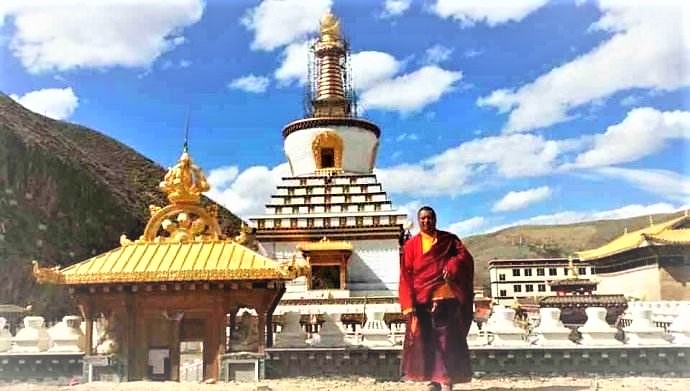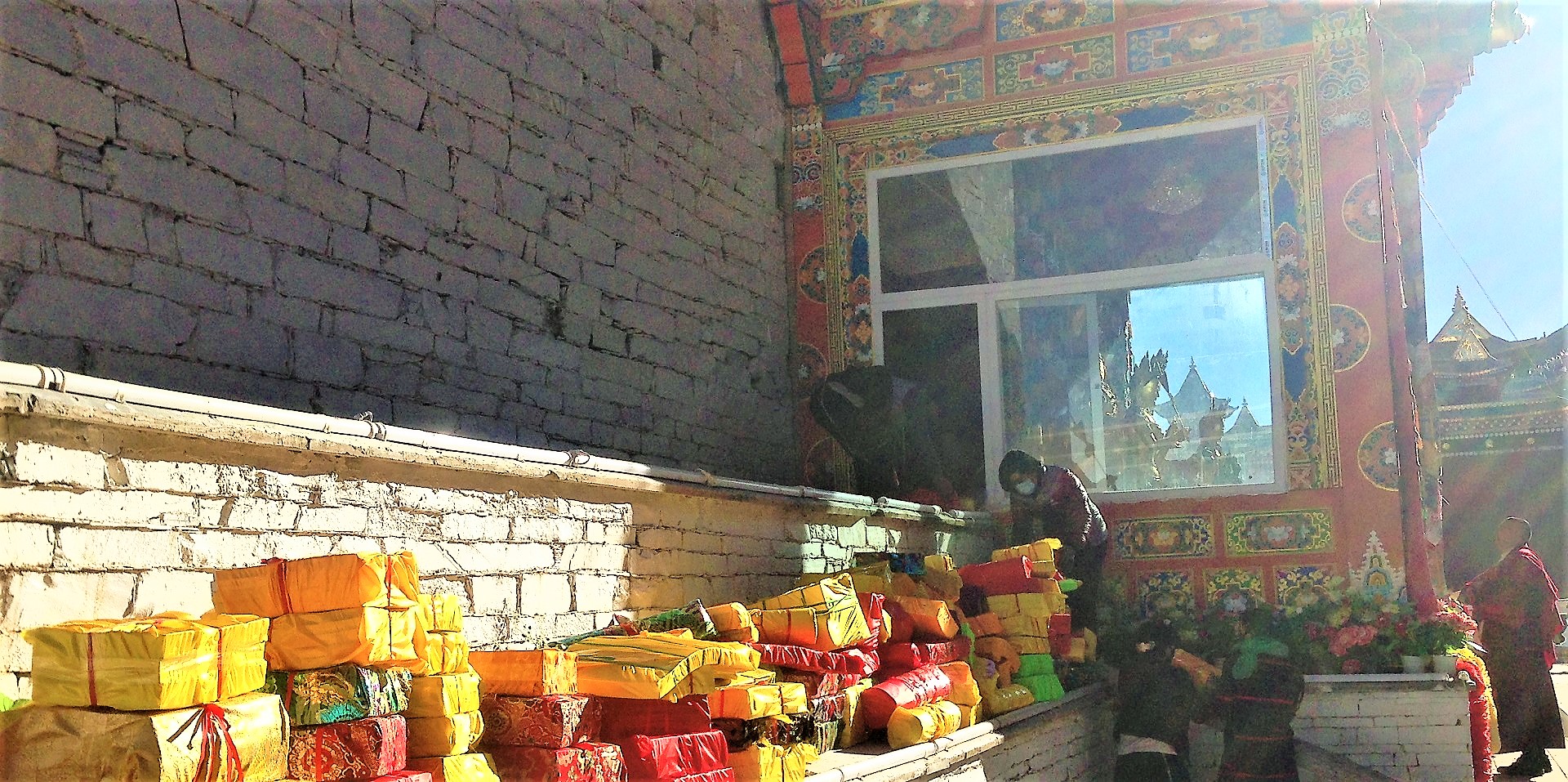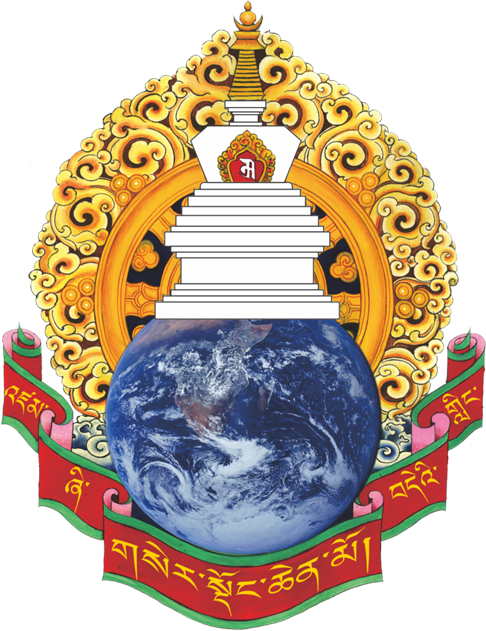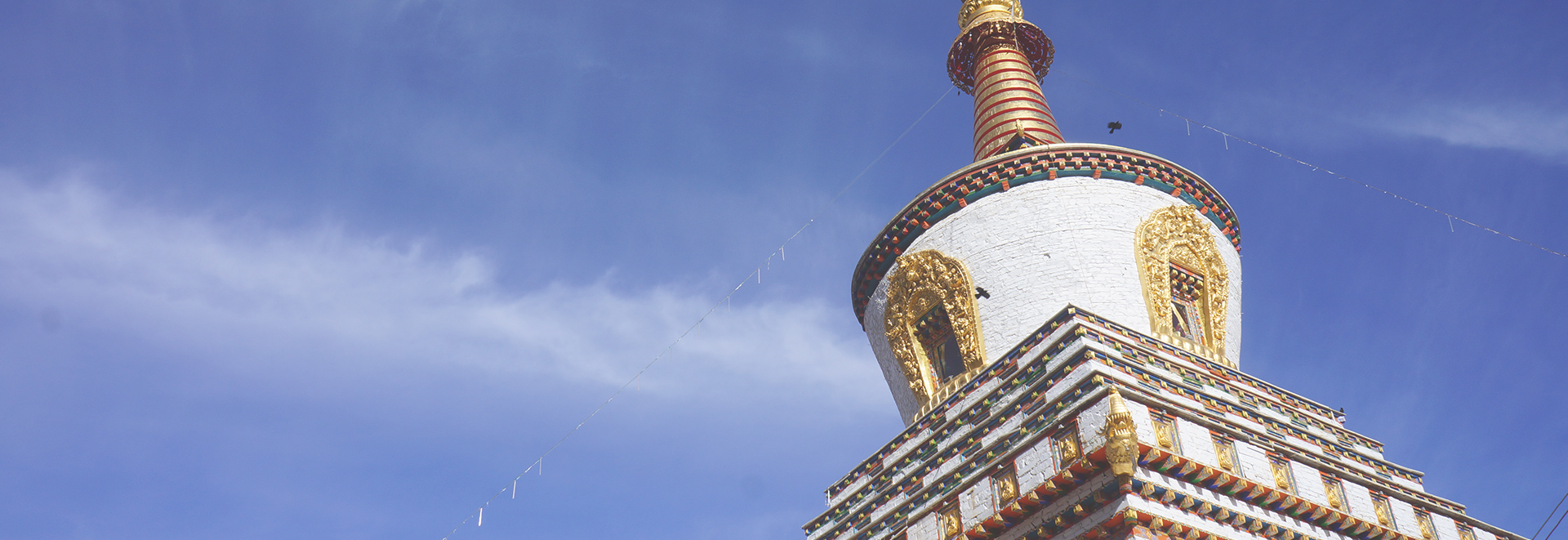Build Stupa
BENEFITS & MERITS

As it says in the Mahāyāna-uttaratantra,
Because their emergence is rare, because they are stainless,
Because they are powerful, because they become ornaments
Of the world, because they are the supreme,
And because they are unchanging, they are Rare and Supreme.
The precious, rare, and supreme Three Jewels, which are likened through these six attributes to a wish-fulfilling jewel, are saviors that release us from all fears of nirvana and samsara, defenders and helpers, refuges and unsurpassed protectors that never deceive us. Therefore, those who seek to attain liberation and the level of perfect omniscience should always at all times keep them as your crown jewels, take refuge in them, supplicate them, and venerate and pay homage to them. As it says in the King of All Dharmas Sutra,
In the world, including the god realms,
Save for the Three Jewels,
No other worthy recipient of offerings exists.
For these reasons, there is no difference in the benefit you receive if you go for refuge with faith and devotion in the actual physical presence of the Buddha himself or if you do so in the presence of a sacred representation of the Buddha’s enlightened body, speech, and mind and build a sacred representation and venerate it. As it says in the Jewel Mound Sutra,
For the one who makes offerings to the Blessed One after he has completely passed beyond suffering or makes offerings while he is still alive, the benefit is the same: equal and identical. This I have stated. Why is this? This is because Tathagathas are fully revealed as the dharmakaya and not fully revealed as the sambhogakaya.
Thus, it is no different than making offerings to the Buddha when he was physically
present. This reason for this is explained in Abhayakara’s Munimatālaṃkāra:
“Buddha” refers to two things: on the ultimate level, it is the perfect coalescence of the three kayas. On the conventional level, reliquary stupas and statues and so forth are the equivalent and the fully-ripened result of the mind of perfect clarity is the equivalent.
The text goes on to give an elaborate explanation.
Furthermore,
The Blessed One spoke thus to his retinue:
“My retinue, which is fourfold,
At present makes offerings to me;
In the future, if offerings are made with faith
To images of me,
There will not be the slightest difference,
And the merit and fully-ripened result will be the same.”
Thus, the Buddha’s blessings
Are unfathomable to ordinary beings;
Therefore, in realms where the Buddha has not appeared,
There are no images of him;
Barbarians in outlying areas have none;
If the teachings disappear, none exist,
And Tirthikas, beasts of burden, and so on will not see him.
Therefore, images [of Buddha] are emanations.
As this explains, images of the Buddha, regardless of what materials are used, are no different [from the Buddha himself]. For this reason, there are great benefits to constructing sacred representations of his enlightened form. There are an enormous number of explanations cited throughout the sutras, tantras, and commentaries, but due to lack of time I will mention just a few here.
As it says in the thirty-first chapter of the King of Samadhi Sutra,
With exquisite images of the Buddha,
Excellently made with polished gems,
Beautiful and exquisite to behold,
Before long, you will attain supreme Samadhi.
Likewise, with excellent images
Made of gold, silver, and sandalwood,
Beautiful and exquisite to behold,
Before long, you will attain supreme Samadhi.
With images made of clay or of wood,
Or those that have been drawn,
And are beautiful and exquisite to behold,
Before long, you will attain supreme Samadhi.
As it says in the Seal of Engagement in Kindling the Power of Faith Sutra,
A noble son or daughter of Manjushri who offers divine food endowed with one hundred flavors each day to as many Pratyekabuddhas as there are grains of sand in the Ganges River and motes of dust in all the world-systems, and likewise offers divine clothing, will not generate as much merit as the incalculable merit generated by a noble son or daughter of Manjushri who draws an image of the Buddha’s enlightened form.
As it says in the Avalokitesvara Sutra,
Whoever creates an image of the Supreme Buddha,
Drawn on canvas, painted on a wall, or cast in gold,
Whatever the differences in features,
All of them, without exception, fully reveal [the Buddha], so listen!
Such a one will not become sightless and blind,
Will not become hunchbacked or have ugly limbs,
Such a one will have a form and have a lovely complexion,
And will be armored with the thirty-two marks of perfection,
And will obtain an extraordinary, utterly pure body.
Such a one will gain eloquence and an attractive, melodious voice,
Be endowed with cognitive alertness and become a sovereign of the world/
Sentient beings who see such a person will feel joyful and happy.
Such a one will refrain from negative actions, have a heart free of hate,
Be free of deceit, not steal, not agitate the king,
Be endowed with power, influence, and renown,
And be friendly and kind with an exalted mind.
When someone creates an exquisite image of the Guide,
That person becomes supreme and is worthy of offerings from many.
That person will become a wise, rich, long-lived,
Powerful sovereign king.
When someone creates an exquisite image of the Guide,
That person will gain the power of Shiva, king of the gods,
Receive abhisheka on the summit of Mount Meru, and transform into Indra,
Revealing a kingdom upon the summit of Mount Meru,
Never lacking in mindful intelligence,
Replete with complete realization, devotion, and discerning awareness.
Able to relieve and comfort everyone in all worlds,
Such a person will be endowed with wisdom and will avoid the hells.
If one makes offerings to the incomparable heart-essence of sentient beings,
One will not enter the realms of animals or the land of Yama.
Know that such a great being will avoid the three lower realms,
And will not return to take rebirth.
When someone creates an exquisite image of the Guide,
That person will transform into powerful Shiva,
And with a lofty, joyful mind make offerings to the Buddha,
Gain faith in the teachings of the supreme Victorious One,
Receive abhisheka in the Abode of Brahma and transform into Brahma,
With an attractive, extremely beautiful fragrance,
And receive the gorgeous, sublime celestial mansion of
Jambu Golden Valley Illuminating Joy.
That person will be a leader endowed with the ten strengths,
And obtain the incomparable heart-essence of sentient beings,
Abiding in all worlds of infinite colors,
Like Thousand-Gold and precious lapis lazuli.
As it says in the Avalokitesvara Sutra,
When one creates an exquisite image of the Guide,
One becomes a supreme being worthy of offerings by many.
Wise, rich, and long-lived,
One becomes a powerful sovereign ruler.
Such passages describe the short-term benefits.
As it says in the second chapter of The White Lotus of the Good Dharma entitled “Skill in Methods,”
Those who paint their representations in murals,
Their entire bodies with a hundred signs of merit,
Whether they paint them themselves or have others do so:
They will all of them attain enlightenment.
These vast benefits apply not only to those who create [images] with pure motivation but also for those who merely draw them for amusement. The same text goes on:
Also those, whether adults or children,
Who in learning, or for their own amusement
Or to entertain others, draw those images
On a wall with a fingernail or with a stick,
They will all of them attain enlightenment.
Such passages explain the long-term benefits and show that the best way to purify karmic obscurations from negative, non-virtuous actions, etc. is to create sacred images [of the Buddha].
As it says in The Teaching on the Extraordinary Transformation that is the Miracle of Attaining the Buddha’s Powers,
If the sons or daughters of noble family, with a feeble recollection of faith and bodhicitta, commission drawings or clay statues of those tathāgatas, and if they do so to liberate friends and relatives, and for the sake of beings who engage in negative actions, abandon the noble Dharma, denigrate the noble ones, commit the five crimes with immediate retribution, take a life, steal the wealth of the Three Jewels, go to the Avīci hell, or take birth in the three negative forms of existence, and if once they have commissioned the drawings or statues, they focus principally on generating compassion toward all these beings and adopt the noble eightfold path, and if they worship the tathāgatas three times in the night and three times in the day with flowers, incense, perfume, garlands, salves, lamps, cymbals, royal banners, and flags, from the eighth day of the waxing moon until the fifteenth, for the sake of liberating those sentient beings…
As it says in the Chapter on the Tathagata’s Body,
For those who have already committed the five crimes with immediate retribution, if they feel faith toward the Tathagata and create an image of him, by that action, sentient beings will endure fewer experiences of hell and will definitely encounter whichever of the three yanas is appropriate.
Such passages describe the purification of intense negative actions and downfalls. As it says in the twenty-sixth chapter of the Eight Commands: Consummation of Secrets,
If one builds thoroughly perfect and complete
Sacred representations of the Tathagata’s body, speech, and mind,
The Buddha’s teachings will remain for a long time;
As long as there are beings to tame, this is taught as a great skillful method.
Such passages explain the tremendous benefits of building statues and other [sacred representations of the Buddha], which include the flourishing of Buddha’s teachings and the arising of happiness and well-being for sentient beings.
Similarly, the unique benefits of creating sacred representations of enlightened speech, including writing, reading, memorizing, and internalizing [the teachings], pondering their meaning, giving them to others, making offerings, and venerating them, are described in great frequency and detail in the sutras, tantras, and commentaries, but again the instances are too many to include them all here. I will mention just a few.
Buddha Maitreya says,
Writing, worshipping, gifting,
Listening, reading, receiving,
Teaching, reciting,
Contemplating, and meditating upon scriptures:
The great being who engages in these ten applications
Generates an immeasurable mass of merit.
As this explains, the merit of these ten Dharma practices is immeasurable, and we rely upon the significance of this statement. Moreover, even in terms of the short-term impacts, there are numerous obvious benefits within our present lifetimes. As it says in the Vajra Essence Dharani Sutra,
In order to write scriptures and teach them widely to others, seek as much learning and knowledge as you can in this life. The Buddha said, “You should learn how to protect the gods, nagas, yakshas, and smell-eaters. Therefore, you should learn all Dharmas without hesitation.”
As it says in the Jewel Torch Sutra,
Ananda, whoever writes down the enumerations of Dharma will not develop eye problems, tongue problems, nose problems, toothaches, problems with the arms and legs, or problems with the brain, the body will not become deficient, develop foul odors, or be killed by other’s harmful actions. Such persons will be protected by all humans and nonhumans, and when they pass beyond this life, completely abandoning all mental constructs, they will be reborn in the happy higher realms among the gods.
Thus, it is clear that even in this very lifetime, the transcendent knowledge that discerns what to accept and what to reject, memory and retention, courageous eloquence, intelligence and other fine qualities increase, and sickness, negative forces, adverse circumstances, and all other unwanted dangers are pacified. Likewise, in future lifetimes one obtains the excellent support of a perfect body, beholds the Buddha, encounters the Dharma, and easily attains all fine qualities, such as a retentive memory and eloquence. As it says in the Dharani for Achieving the Boundless Gate,
Until unsurpassed enlightenment is reached,
Meditative absorption and clairvoyance,
Retention and body and enjoyments
Will never deteriorate, for Buddha has been glimpsed.
The same text continues:
Having heard the sutras, if one rejoices,
Copies the scriptures, memorizes and recites them,
One produces untold masses of merit,
Impossible for any sentient being to comprehend.
Seeing the Victorious Ones in all of one’s lifetimes
And gaining inconceivable faith in them,
One will come to understand the profundity of the sutras,
And swiftly attain supreme enlightenment.
This explains that [encountering Buddha’s speech] is the source of immeasurable benefits that last until ultimate, manifest, perfect enlightenment is achieved. In particular, listening to, contemplating, and meditating upon the collections of common and uncommon Mahayana scriptures and memorizing them, reciting them, printing volumes of them, and so forth bring roots of virtue that are uniquely sublime. As it says in the Condensed Prajnaparamita Sutra,
Even if an Arhat were to tame all the sentient beings arrayed
In the domain of the Ganges River,
The merit of copying the Prajnaparamita Sutra
And gifting its volume to a supreme sentient being would be superior.
The same is true for all the Mahayana sutras and tantras, all of which bring similar benefit. In fact, the blessing and benefit of memorizing or writing down a single four-line verse from one of the [Mahayana sutras or tantras] is inconceivable. As it says in The Teaching on the Extraordinary Transformation that is the Miracle of Attaining the Buddha’s Powers,
…suppose someone were to set the beings of Jambudvīpa on the noble eightfold path and, after having done so, venerated and worshipped the Tathāgata for a hundred thousand divine years with all the necessities of life there might be—compared to such a person, someone who listens to just one four-line stanza drawn from the various teachings of the Dharma, keeps it in mind, copies it or commissions it to be copied, and promulgates it to others will have a vastly greater increase in merit.
Not only that, the simple recollection of one name from inside the sutras and tantras brings unfathomable blessing and benefit. As it says in The King of the Array of All Dharma Qualities,
Blessed One, just to contemplate Avaloki¬teśvara’s name completely fulfills all one’s aspirations, not to mention worshiping the Thus-Gone One, or having faith in this Dharma teaching, holding it, reading it aloud, writing it down, commissioning it to be written, worshiping it with great offerings of clothes and ornaments, and adorning it with ornaments!
As it says in the Mahayoga Tantra of the Heruka’s Proclamation of Certainty,
If, for instance, a flame is placed
In a vessel filled with butter,
The surface of the butter will melt,
And the vessel’s impurities will be destroyed.
Likewise, the name “Shri Heruka”
Destroys negativity.
By merely concentrating your mind on it,
Reading it, reciting it, or writing it down,
You will attain the enjoyments of the higher realms,
Or attain the level of sovereign.
It is also taught that merely memorizing dharanis and exalted names brings inconceivable benefit, but the quotes are too numerous to include here.
For those who wonder whether such teachings, which were given long ago in a golden era, no longer apply in our modern degenerate era, this is absolutely not the case. As it says in the White Lotus of Compassion Sutra,
In the future, in the final five-hundred-year period, even simply writing down or wearing this will such generate enormous merit that the mass of merit garnered by a bodhisattva who engages in the six transcendent perfections for ten great aeons pales in comparison.
As it says in the Avatamsaka Sutra,
In the final five-hundred-year period,
I will abide in the form of scriptures.
Consider them as identical to me,
And treat them with respect.
As this and other passages explain, if one fails to venerate and place offerings before even so much as a single letter of the alphabet, which is the support of precious jewel of the Dharma, one has contradicted the refuge precepts and depleted one’s merit. This is considered a rejection of the Dharma, so it is extremely important that we faithfully and conscientiously show respect and make offerings [to the Dharma].
We are taught that during the degenerate era, upholding even one aspect of moral discipline and engaging in even a little listening and contemplation has especially great benefit. Beyond this, if we construct sacred representations of enlightened body, speech, and mind or temples to house the Sangha of the ten directions or Dharma sanctuaries, the benefit is even greater. To briefly describe this, as it says in the Mindfulness of the True Dharma Sutra,
Creating beautiful sanctuaries and sacred representations,
Constructing living quarters for the Sangha, and so on,
Will forever generate more and more merit.
Even after ten million aeons,
The merit will never be lost.
Likewise, it says in the Verses on King Prasenajit Sutra,
Any person who creates a shrine hall for the Victorious Ones,
And if beings walk around it,
Will have a resplendent mansion like the abode of Indra,
And will always at all times be joyful.



